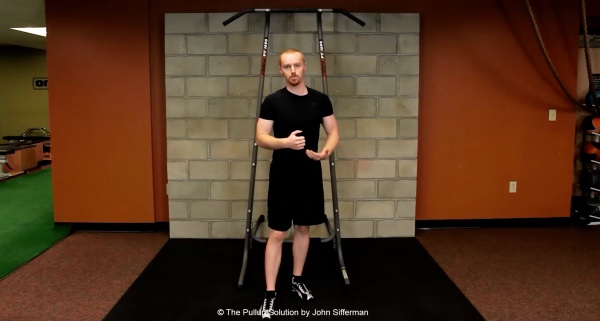 The Pull-Up Solution: A Review
The Pull-Up Solution: A Review
This post contains affiliate links to a program we use, have reviewed and recommend.
Visit The Pull Up Solution Website
Ask any trainer and they all agree: Pull-ups are one of the best upper body exercises, even when you compare them to free-weight movements.
Few exercises stimulate upper back muscle growth as much as pull-ups. No other exercise increases your upper back strength like pull-ups while placing zero strain on your lower back.
Pullups are superb for building your upper arm and gripping muscles as well, especially the chin-up (supinated) grip which really blasts the biceps.
And as a body weight exercise, you can’t beat the convenience. No gym or fancy machines needed, only a pull-up bar.
The problem is, what if you’re not very good at pull-ups?
What if you can’t do many pull-ups, not even full set of 6 or 8 reps? What if you can’t do a single unassisted pull-up? If you’re in this group, it’s nothing to be ashamed of – you’re in the majority.
Pull-ups are hard. After all, you’re lifting your entire body weight hanging from your hands with the strength of your back and arm muscles. If you carry even a few excess pounds, pull-ups are even harder.
If you agree that pull-ups are an important exercise, but you’re frustrated because you can’t do as many reps as you want to, or you can’t do any unassisted pull-ups yet, there’s good news:
Almost everyone can master the pull-up, but you need the right kind of training system. It has to start where you are now, and let you build up from there.
That’s another great thing about pull-ups: With the right coaching, you can learn to make pull-ups easier with various types of assistance tricks (regressions), and you can make them hard enough (progressions) to challenge the fittest athletes on earth.
The Pull-Up Solution program, by John Sifferman, is just such a system – progressive and personalized.
Who is the Pull-Up Solution program for?
The Pull-up Solution program is for everyone at any strength level or training experience level because it’s scaled – it allows regression or progression for each individual.
It doesn’t matter if you can’t do a single pull-up yet. In fact, it’s assumed that most people can’t do a pull-up at first, so The Pull-Up Solution devotes great attention to building up to that first unassisted rep.
If you have some training experience, and you’re doing a handful of consecutive reps, but you’re not satisfied and want to do more, The Pull-Up Solution course can help you increase your rep number and build up to 8 to 12 reps in a short time (which we know is an ideal rep range for maximum muscle building).
If an advanced trainee is doing full sets of pull-ups, but wants to increase the reps to 15, or even to 20, 25, or 30 reps, there are strategies to accomplish that as well.
I’ve been doing pull-ups for decades and while I couldn’t do any when I was a beginner, I built up to 15 to 20 reps. With extra work I reached 25 consecutive reps, but then always hit an unbreakable plateau. It was like the 26th rep was physically impossible.
Following the system in John’s Pull-Up Solution program, I reached a lifetime personal record of 26 reps, then continued on to 27, 28, 29, and ultimately 30 consecutive reps. I did it in less than 2 months, after being stuck for 20 years. That’s why I can say this works for advanced trainees too.
Other advanced lifters might want to aim for one-rep max goals. If you want to strap 50 pounds, 75 pounds, or even more around your waist and pull yourself up with that added resistance, John’s course shows you how that’s done as well.
What kind of program is The Pull-Up Solution?
The Pull-Up Solution is a 3-month training program for pull-ups (and or chin-ups) broken into 3 phases. Right from the first phase, almost everything you’ve ever learned about resistance training gets thrown out the window. The workout structure in this phase was the exact opposite of what I had done in the past with my bodybuilding training.
The 2 key principles that made the biggest difference were frequency (training the pull-up more often) and fatigue management (not training to failure, or even close to it). I also focused on accumulated total volume rather than standard set and rep structures. Being willing to change my usual workout style using these principles is for sure what helped me hit my personal records.
The second stage (month two) is pyramid and high-volume training. After a brief break (deload), you increase the volume, which puts your physical capacity and recovery to the test. This builds on top of what you did in phase one. That’s why you continue seeing progress instead of hitting the plateau that happens to most people around the 6 to 8 week mark.
The final phase (month three) is the peaking stage. Here the training volume goes down, but the intensity goes up. This change, which includes making the workouts shorter (though not easier), is smart. It’s what allows you to squeeze out even more progress before hitting a plateau. The other objective of this phase is to prep you for maximum effort pull-up sets.
What you get in The Pull-Up Solution package
The Pull-Up Solution is a comprehensive, multi-media training course. It includes an extensive video library, audios, manuals, and logsheets, all downloadable.
The course is divided into 3 main components:
1. The manual & quick start guide
This is a 45-page e-book that shows you how to start in minutes. Here is where you find the entire 12-week training program (broken into 3 phases). The quick start section of the manual helps you get going without having to watch every single video first.
It’s the “personalization guide” section that shows you how to customize the plan based on your strength level. You may be starting with zero reps and going for rep one, or you might be starting with a personal best of 10 reps and aiming for 15 or 20. Whatever the case, this guide shows you how adapt the plan for your goal.
The customizations not only account for experience and strength level, but also for demographics. That includes tips for women (which might be different than men) and for older trainees (which might be different for younger people).
Different goals are considered as well. If you’re after strength or endurance, you’ll learn how to adapt a pull-up program for those objectives. If you’re a bodybuilder and want to max out hypertrophy, you get coaching for that too.
2. Over 30 instructional videos
Thirty videos may sound like a ton of material to wade through, but the videos are all short and concise. John covers one topic per video, and most of them are only 2 to 4 minutes long.
John demonstrates all the form techniques to get the best results and avoid injury. This includes the basics, as well as finer details and advanced tactics that most people don’t know about.
There are 3 sets of videos.
The first bundle is the 8 pull-up technique videos. You get advice on positioning for grip, elbows, shoulders, hips, and spine. You get tips on breathing and how to engage your core muscles as well. John shows you how the smallest tweaks in body or arm position can sometimes instantly improve your performance.
The second group of 10 videos shows exercise technique instructions. They average about a minute in length. You see every different pull-up variation demonstrated, including 2 angles, along with John’s commentary.
The third bundle of videos (11) is called “tips and tricks.” You learn common mistakes, different grip options, unusual pullup variants and unique training techniques. You’ll also get tips on grip strength, tempo, and stretching.
The fourth and final set of videos includes one video on warming up and another on cooling down. This, when combined with using proper pull-up form will help you stay injury-free.
3. Progress Tracking Journal
The last major piece of The Pull-Up Solution program is the Progress Tracking Journal, which will help you track your improvements each time you train. It’s available in printable and digital formats, and has been designed so all you have to do is enter your numbers as you go along.
Advanced training program
When you complete the 3 phases of the main program you can simply repeat it, using some of the more difficult progressions you learned in the videos. For very advanced trainees (men and women who can do 15-20+ or 10-12+ pull-ups respectively), another option is the advanced program.
The more advanced you get, the slower your results come, but being advanced doesn’t mean settling for merely maintaining. You can keep increasing your performance year after year if you have a plan designed for stronger, more experienced trainees.
John’s advanced program has 2 phases. Both include weighted pull-ups with progressive volume and progressive resistance. That combination virtually guarantees you make gains beyond your previous best.
The advanced workouts are periodized so there’s a mix of rep ranges. This helps prevent injury while maximizing strength and building muscle at the same time.
Audio bonuses (MP3)
The Pull-Up Solution also includes a series of audio interviews as bonuses. It’s not mandatory to listen to them all to get started, but it’s a valuable adjunct to the program.
When you look at the list, you’ll notice the interviews are with some of the world’s top pull-up training experts in specific areas such as bodybuilding (hypertrophy), strength training, tactical training (law enforcement and firefighting), female training, martial arts conditioning and so on.
How long will it take to see improvement? How much time will the training take?
For me, it took less than 2 months to beat my lifetime personal record on bodyweight chin-up reps. John said that he went from barely getting 6 reps all the way to 30 reps in only 3 months, which may not be typical, but it shows what’s possible.
Clients of John have shared their results on his website as well as in the manual. Dom went from 0 reps to 5 with strict form in only one month. Kristian went from 0 reps to 15 in 4 months.
I don’t know what you might achieve, as results will vary for a lot of reasons. But I have no doubt everyone will see improvement within a month and reach a major goal within a few months. It won’t happen overnight, but you’ll make progress if you follow the instructions.
An encouraging point to know is that on this type of program, you almost always make the most progress in the first several weeks. Call these results “newbie gains” if you like. It’s not uncommon to go from zero pull-ups to 3 to 5 in the first month.
Anyone can improve their pull-ups, even if you’re on the heavier side, even if you’re over 50, and even if your upper body pulling muscles are a weak point. Just remember, it won’t be easy. You’ll have to put in the work and possibly, be prepared to train more often than you have in the past.
What about the time required? Will it take hours? Is it mandatory to do you the pull-ups every day method to make it work?
Like the difficulty level of the exercises (there are easier and harder versions of pullups), you can also customize the program based on how much time you’re willing and able to spend.
If you’re an athlete who wants to capture every last percent of gains, or if you’re going after challenging goals, you’ll need to invest a little more time. Some phases of the program call for training up to 5 or 6 days a week. But if you’re strapped for time, or don’t think you’ll recover from high-frequency training, you can still make great progress with only 3 sessions a week.
In addition, some of the techniques, like “Grease-The-Groove” are designed so you that even though you do train frequently, it could involve just a few minutes at a time. If you have a pull-up bar at home, that makes it quite easy to do.
The bottom line
I’ve known John Sifferman a long time. John is not only a respected fitness industry colleague, he’s also been a business associate who worked with our Burn the Fat company for years. He was a fantastic guy to collaborate with, and I had the opportunity first-hand to see how knowledgeable he is about exercise programming.
But more than simply endorsing a well-designed training course, I’m an actual case study myself. Granted, I was already doing above average pull-up numbers, but I was also hitting a brick wall when it came to making any more progress.
I didn’t even use every technique in the program. By applying just a couple of the ideas from The Pull-Up Solution, I hit my lifetime personal chin-up record, and then went on to beat it 4 more times and crack the 30 reps mark. There’s no question: The Pull-Up Solution program works.
To download the entire course videos, manuals, and audios, visit: www.PullupSolution.com
-Tom Venuto
Disclosure: Burn the Fat Blog posts may use affiliate links to third-party websites and online stores and may earn a commission if products or books are purchased. This helps support our work and cover costs of publishing this blog. We never link to or recommend products we haven’t used or books we haven’t read and fully endorse. However, always do your own due diligence if purchasing from a third party merchant on the internet.






